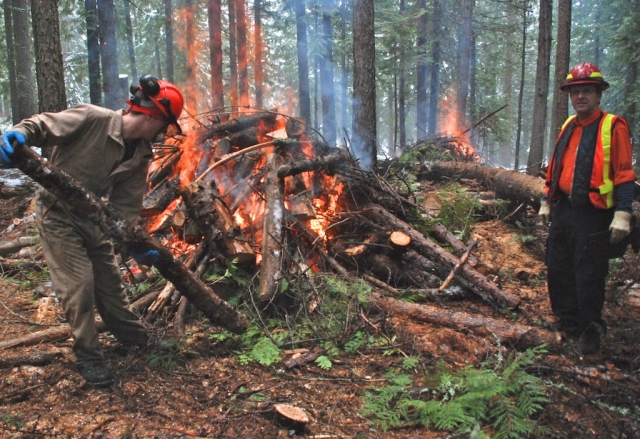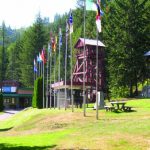Wildfire prevention fuel treatments to hit high gear this spring around Rossland
Provincial grants under the Strategic Wildfire Prevention Initiative (SWPI) totalling more than $145,000 have been awarded to Rossland for its Community Wildfire Protection Plan (CWP Plan), both for prescriptions completed last fall for another 25 hectares of “high hazard interface lands,” and for the actual fuel treatments that will be carried out this spring.
Council agreed with Coun. Kathy Moore on Mar. 26 that the awards were “excellent news,” as she congratulated staff on the successful applications, and project manager Don Mortimer for his “excellent job in the fuel management program.”
High hazard interface lands are areas on the boundary of communities where, if forest fuels are allowed to build up, the community is put at an increased risk of forest fires. Fuel treatment programs “reduce the chance that a fire will burn hot or spread quickly through the treated area,” Mortimer said.
Rossland’s CWP Plan was tabled in 2009 under the provincial CWP Program. “The plan is the first thing you have to have,” Mortimer explained. The plan identifies priority areas around Rossland where hazardous forest fuels have built up, but also addresses other important components of hazard mitigation such as wildfire prevention, community and homeowner preparedness, fire response, and legislation.
Mortimer added, “You don’t get any money without a plan.”
A fuel treatment prescription for some 22 hectares of land was funded in 2010 by the Tri-Regional District (TRD) Fuel Treatment Program, followed by funding for the actual treatment that began in the fall of 2010 and was completed in the spring of 2011.
The TRD grants allowed the fuel treatment program to proceed at no cost to the city. It was uncertain at the time, however, whether funding would become available to continue work identified in the plan.
Then, later in 2011, the provincial government also announced the SWPI program to which Rossland successfully applied for about $18,000 towards the total cost of roughly $22,000 for prescriptions that were completed last fall.
Prescriptions are prepared by professional foresters to address a wide range of issues beyond just wildfire mitigation. Issues include watershed protection, slope stability, endangered species’ habitats, invasive plants, and considerations for archeological sites.
Based on prescriptions for 25 hectares in four high hazard interface areas—Black Bear, Highway, Iron Colt, and Star Gulch areas—Rossland successfully applied to SWPI for $127,000 towards the total cost of $141,000 for fuel treatments in these areas this spring.
A contractor has not yet been selected for the fuel treatment, but the work will be very similar to that completed by Apex Forest and Wildfire Services out of Nelson in 2010 and 2011.
“Trained local crews worked hard to cut, pile and burn the areas before the snow got too deep in the fall [of 2010] or the fire hazard increased in the spring [of 2011],” Mortimer said.
Crews followed a detailed burn plan established by the fire department and forestry officials. “Hundreds of piles of woody debris were burned using a ‘hot fed’ pile burning technique that keeps burn piles hot and relatively smoke free,” Mortimer said. “Daily consultation with Ministry of Environment forecasters also avoided burning under poor smoke venting conditions.”
Now crews will do it all again in the newly prescribed areas.
The pictures appended to the article, below, show the results of previous fuel treatments. There is also a map of the high hazard interface lands that have been targeted by the CWP Plan.
“Note the big reduction of woody surface debris, the slashy material that causes forest fires to burn hot,” Mortimer said. “Also note the removal of small diameter trees, ‘ladder fuels’ that can spread a surface fire upwards and create fast spreading ‘crown fires’.”
The larger logs are typically cut so they contact the ground and are left behind to rot over a period of time. This builds forest soil and also “creates habitat for all the little critters,” Mortimer said. “It saves us work too, and it certainly doesn’t create a fire hazard—when was the last time you tried to start a camp fire with big logs?”
Although hazardous trees are felled, standing dead stems are left behind wherever possible as ‘wildlife trees’ to provide habitat for birds and small animals.
When it’s possible, firewood is bucked into lengths and piled for local residents to pick up.
“The public response has been positive,” Mortimer reported. “People like the look of the treated forest and appreciate the reduced wildfire hazard.”
“Future plans include revising Rossland’s CWPP to incorporate the important watersheds in the northern portion of Rossland’s municipal footprint and applying for grants to complete prescriptions and fuel treatment work in these important watershed areas,” Mortimer said.
Rossland’s treatment of public lands will be complimented by fuel treatments this spring by Teck Minerals on some of its “high hazard interface lands” adjacent to Rossland.
In addition, Mortimer encouraged other private landowners to engage in fuel treatment work as well, for the safety of their homes and the community as a whole.
“Soon there will be more information coming out on a national initiative by Fire Smart Canada, a community recognition program to encourage private land owners to do the fuel treatment on their own land,” Mortimer said.
The Fire Smart program will provide landowners a template based on an American program, Firewise USA, which had a “huge, unprecedented uptake from at-risk public,” Mortimer said. “You give people the tools and organisational modality to do it, and they get right after it.”
Canada’s program is likely to be unrolled in the next year or two, and will apply equally to small neighbourhoods as well as big towns.
“Slave Lake has certainly sobered up a number of jurisdictional authorities,” Mortimer said. “We can do better providing communities with mitigative strategies.”
Questions and concerns regarding the current fuel treatment programs should be directed to Mike Maturo, Rossland’s manager of planning and development services at mikematuro@rossland.ca, or 250-362-7396.
























